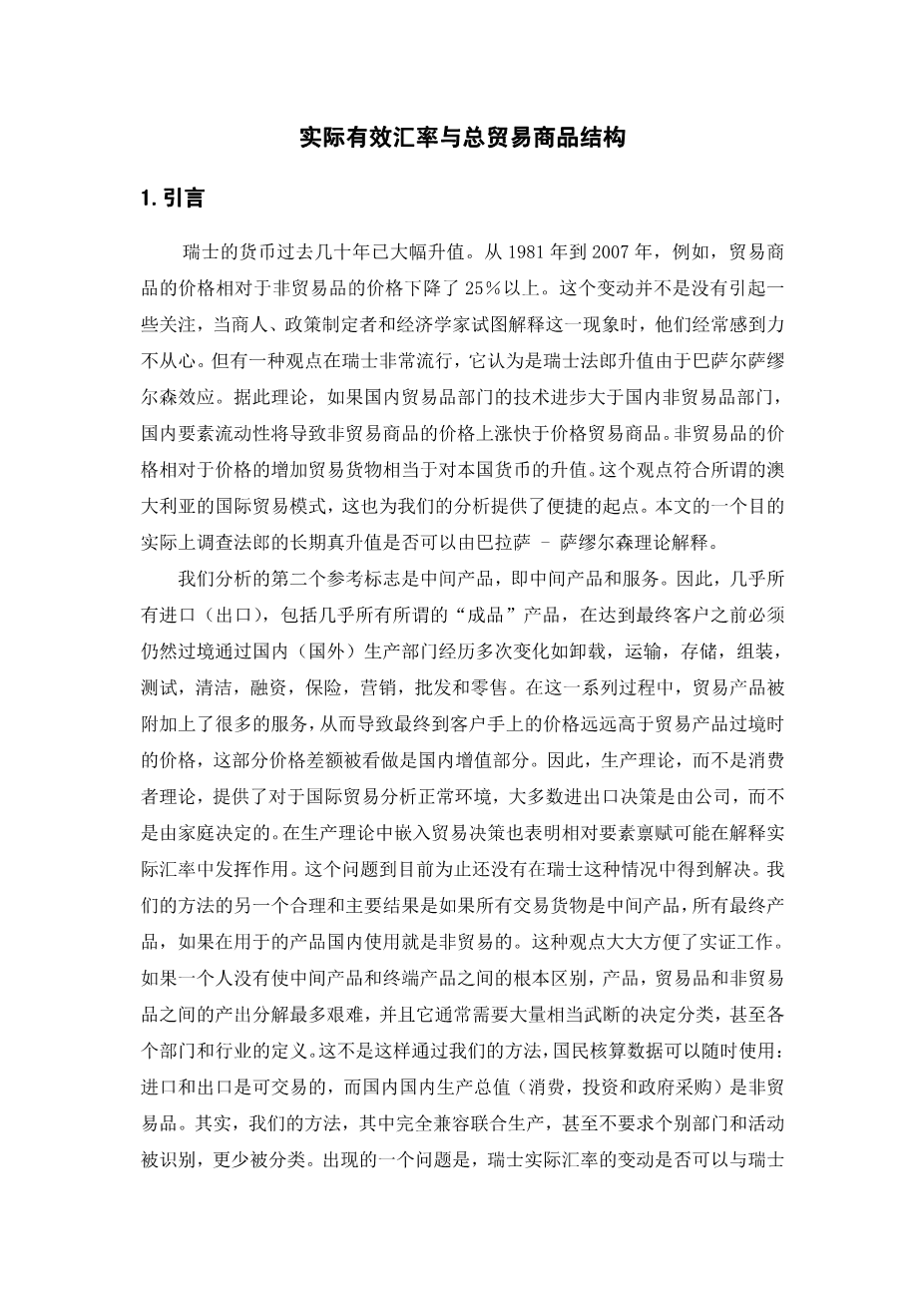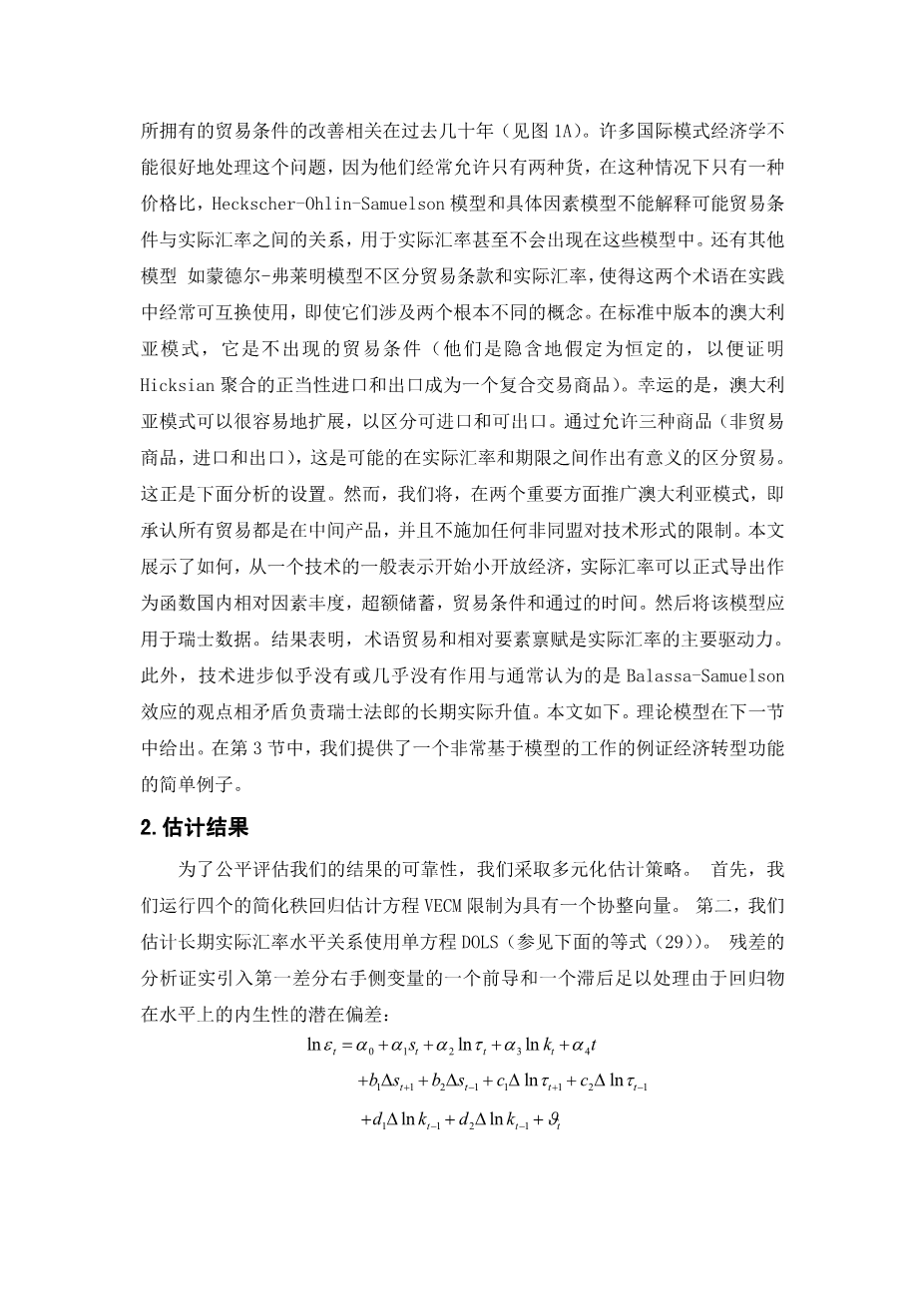The real exchange rate and the structure of aggregate production
1.Introduction
Switzerland's currency is known to have appreciated considerably in real terms over the past several decades. From 1981 to 2007, for instance, the price of traded goods has fallen by over 25% relative to the price of nontraded goods (see Figure A1). This movement is not without causing some concern, among business people and policy makers alike, and economists are often at a loss when trying to explain this phenomenon. One hypothesis that is frequently aired in Switzerland, though, is that the appreciation is due to a Balassa-Samuelson effect.1 Thus, if technological progress is larger in the traded good sector than in the nontraded good sector, domestic factor mobility will result in the price of nontraded goods rising faster than the price of traded goods. An increase in the price of nontraded goods relative to the price oftraded goods is tantamount to a real appreciation of the domestic currency. This view, which is consistent with the so-called Australian model of international trade, provides a convenient starting point for our analysis.2 One purpose of this paper is indeed to investigate whether the secular real appreciation of the franc can be explained by a Balassa-Samuelson effect.
A second reference mark for our analysis is the recognition that most international trade is in middle products, i.e. intermediate goods and services.3 Thus, nearly all imports (exports), including almost all so-called “finished” products, must still transit through the domestic (foreign) production sector and go through a number of changes– such as unloading, transporting, storing, assembling, testing, cleaning, financing, insuring, marketing, wholesaling and retailing – before reaching final demand. During this process, traded products are combined with local factor services, with the consequence that the cost to the end-user is typically well in excess of the price charged at the border, the difference being accounted for by domestic value added.
Hence, production theory, rather than consumer theory, provides the natural setting for international trade analysis,4 all the more so that most import and export decisions are made by firms, not by households. Imbedding trade decisions in production theory also suggests that relative factor endowments might play a role in explaining the real exchange rate. This question has not been addressed until now in the Swiss context. Another logical, and indeed major consequence of our approach is that if all traded goods are middle products, then all end-products, i.e. the products intended for domestic use, must be nontraded.5 This view greatly facilitates the empirical work. If one fails to make this fundamental distinction between middle products and end- products, the decomposition of output between tradables and nontradables is most arduous, and it requires often a large number of quite arbitrary decisions as to the classification and even the definition of various sectors and industries. This is not so with our approach, for national accounts data can then readily be used: imports and exports are tradables, whereas the domestic GDP components (consumption, investment and government purchases) are nontradables. In fact, our approach, which is fully compatible with joint production, does not even require that individual sectors and activities be identified, much less be classified.
One question that arises is whether the movements in the Swiss real exchange rate can be associated with the improvements in the terms of trade that Switzerland has enjoyed over the past few decades (see Figure 1A). Many models of international economics are not well equipped to deal with this question, for they often allow for two goods only, in which case there can be only one price ratio. Thus, the Heckscher- Ohlin-Samuelson model and the specific factors model cannot explain the possible link between the terms of trade and the real exchange rate, for the real exchange rate does not even show up in these models. There are other models – such as the Mundell-Fleming model – that make no distinction between the terms of trade and the real exchange rate, so that the two terms are often used interchangeably in practice, even though they refer to two fundamentally different concepts. In the standard version of the Australian model, it is the terms of trade that do not appear (they are implicitly assumed to be constant in order to justify the Hicksian aggregation of imports and exports into a composite traded good). Fortunately, the Australian model can easily be extended to distinguish between importables and exportables. By allowing for three goods (an nontraded good, an import and an export), it is possible to draw a meaningful distinction between the real exchange rate and the terms of trade. This is precisely the setting of the analysis that follows. We will, however, generalize the Australian model in two important respects, namely by recognizing that all trade is in middle products and by refraining from imposing any nonjointness restrictions on the form of the technology.
This paper shows how, starting from a general representation of the technology of a small open economy, the real exchange rate can be formally derived as a function of domestic relative factor abundance, excess savings, the terms of trade and the passage of time. The model is then applied to Swiss data. The results suggest that the terms of trade and relative factor endowments are the main drivers of the real exchange rate. Moreover, technological progress seems to have little or no role to play, which contradicts the commonly held view that it is a Balassa-Samuelson effect that is responsible for the long-run real appreciation of the Swiss franc.
The paper proceeds as follows. The theoretical model is presented in the next sectio
剩余内容已隐藏,支付完成后下载完整资料


英语译文共 5 页,剩余内容已隐藏,支付完成后下载完整资料
资料编号:[486259],资料为PDF文档或Word文档,PDF文档可免费转换为Word


